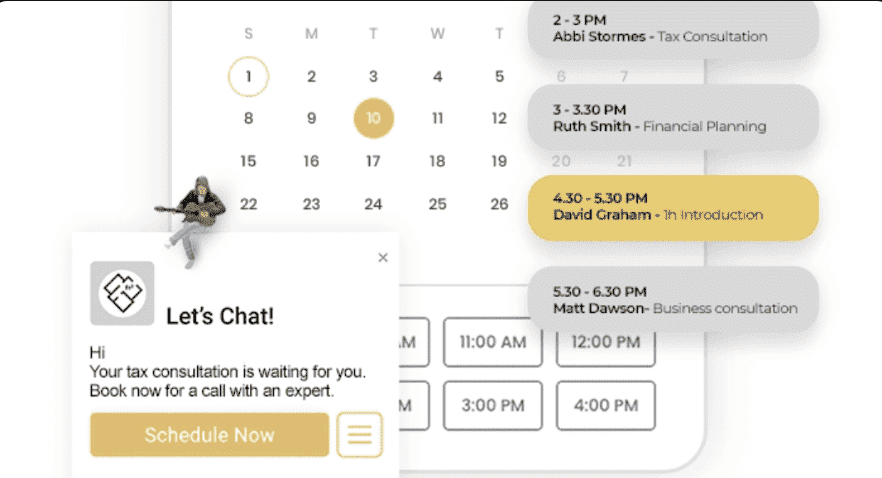The 10 Best CRMs for Contractors in 2026
CRMs compared for first timers and those looking for a better option
Will Schmidt - September 30, 2025
Contractor CRM Summary
If you’re a contractor juggling bids, jobs, and follow-ups, the right CRM can be a game-changer. Studies show using a CRM can boost sales by ~29% and improve productivity by 34% on average[1] – not to mention an impressive $8.71 return for every $1 spent[2]. In this guide, we’ll chat through the best CRM options for 2026 in down-to-earth terms. Whether it’s your first CRM or you’re itching to switch, grab a coffee (or a whiskey) and let’s find the perfect fit for you.
FREE CRM Download
Want a FREE CRM built out of Google Workspace that has HR applications and guides, sales guides, commission ideas, employee tracking, and more?
Research Methodology
All of the information about these CRMs comes from secret shopping free demos, our current clients who have the systems, 20+ additional online articles we read from, and lastly, personal experience in using them in free trials. If for some reason, any information is outdated, or you have an idea how to improve this article, please contact us at info@talentsintoprofits.com. Thank you!
Sections and Topics
- Quick Table Comparison of all CRMS
- VCita
- Jobber
- HubSpot
- Job Nimbus
- Buildertrend
- PipeDrive
- Service Titan
- Housecall Pro
- TIP's Google CRM Solution
Quick Contractor CRM Comparison Chart
Use this Contractor CRM chart to quickly identify our scoring of each major CRM. We hope this helps you in your decision making process as well as what sections to read throughout this blog.
CRMs Rankings - "Easiest to Learn and Use"
| CRM | Overall Score | Easy to Learn | Easy to Use | Mobile App |
|---|---|---|---|---|
| Housecall Pro | 9.3 | 9 | 9 | 10 |
| Jobber | 9.0 | 9 | 9 | 9 |
| HubSpot | 8.7 | 9 | 9 | 8 |
| Pipedrive | 8.7 | 9 | 9 | 8 |
| JobNimbus | 8.3 | 8 | 8 | 9 |
| vCita | 7.7 | 8 | 8 | 7 |
| TIP | 7.0 | 9 | 9 | 3 |
| Buildertrend | 6.7 | 6 | 8 | 6 |
| ServiceTitan | 6.3 | 6 | 8 | 5 |
What CRMs have the most and best features?
| CRM | Overall | Products | Contract/Esign | Invoicing | Email/Chat/Portal |
|---|---|---|---|---|---|
| vCita | 9.5 | 10 | 10 | 9 | 9 |
| Housecall Pro | 9.5 | 10 | 9 | 10 | 9 |
| Jobber | 9.3 | 9 | 9 | 10 | 9 |
| Buildertrend | 8.3 | 7 | 9 | 9 | 8 |
| ServiceTitan | 9.5 | 10 | 10 | 10 | 8 |
| JobNimbus | 8 | 8 | 9 | 9 | 6 |
| TIP | 7.5 | 10 | 10 | 0 | 10 |
| HubSpot | 7.3 | 8 | 8 | 5 | 8 |
| Pipedrive | 6.8 | 8 | 7 | 5 | 7 |
The 3-seat CRM Secret Shop Analysis
| CRM | Year 1 Cost | Annually |
|---|---|---|
| TIP | Free | Free |
| vCita | $2,500 | $2,500 |
| Pipedrive | $2,500 | $2,500 |
| Jobber | $3,000 | $3,000 |
| Housecall Pro | $3,000 | $3,000 |
| JobNimbus | $5,000 | $5,000 |
| Buildertrend | $5,000 | $5,000 |
| HubSpot | $7,500 | $7,500 |
| ServiceTitan | $10,000 | $10,000 |
CRM with HR applications?
At this time, and to the best of our knowledge, only TIP's custom Google CRM both HR modules for employee tracking, bonus structures, and can help analyze employee salary versus total employee costs.
VCita CRM

All-in-One CRM for small to medium sized contractors
If you’re a solo contractor or small crew who needs scheduling, payments, and client management all in one place, vCita might be your new best friend. It’s designed to lighten your load by consolidating tasks – think appointments, invoices, and customer chats – into a single app. Here’s how vCita stands out and where it might make
your life easier (or harder):
VCita features that make life easier
vCita isn’t just a calendar or just a CRM – it combines online scheduling, automated client reminders, payment collection, and a built-in customer database[3]. That means you can track client conversations, appointments, and even invoices without jumping between apps. This all-in-one approach saves you time and keeps details from slipping through the cracks[3]. For example, clients can book you via a self-service portal (nights and weekends too) and receive automatic confirmations, so you’re not stuck on the phone. In fact, 97% of appointment software users say confirmations and reminders are crucial, and vCita bakes that in from the start[4]. The result? Less back-and-forth with clients and more time on the job site.
#1 strength is VCita's ease of us
One thing you’ll love is how client-friendly vCita is. Clients can schedule appointments 24/7, pay invoices online, and even access a portal to sign estimates or view project updates[5][6]. This not only impresses customers (no more “I’ll swing by your office to pay” hassles) but also gets you paid faster. vCita integrates with tools like QuickBooks for accounting and Zoom for virtual meetings, so it fits right into your workflow[7]. The software is known for being easy to use – many small businesses manage to automate tasks that used to require an assistant. As one user put it, “Even if my assistant quit today, vCita could do 95% of her work”[8][9]. That’s a strong testament to its simplicity for solo operations.
VCita's limitations
Now, vCita isn’t perfect. If you’re expecting deep customization or tons of third-party add-ons, you might hit some walls – it’s best for businesses who can work with its built-in features[10][11]. Some users have reported occasional glitches or slow load times (imagine not being able to log in right when you need an important client file – frustrating!)[12][13]. Additionally, while vCita covers the basics (contacts, scheduling, payments), it lacks advanced project management tools that larger contractors might need. Think of it as a reliable pickup truck, not a heavy-duty crane. And be aware of customer support – a few reviewers noted they wished for more hands-on support when issues arose[14]. Bottom line: for straightforward scheduling and client management, vCita is a champ, but it’s not built for highly complex workflows.
Ideal for small teams
vCita’s sweet spot is independent contractors, consultants, and small home service teams that need an easy, integrated CRM without a big learning curve. If you’re a one-person show or have a couple of staff, it covers your bases from lead to payment. Pricing is tiered by features: plans start at about $29 per month (billed annually) for the basics and go up to around $93/month for advanced packages[15]. While not the cheapest CRM on the block, remember it rolls several tools into one – you might otherwise be paying separate subscriptions for scheduling, invoicing, email marketing, etc. There’s a free trial to take it for a spin, which we always recommend. Try booking a fake appointment with yourself and sending a test invoice – you’ll get a feel for how it could fit into your day-to-day. If you value all-in-one convenience and client self-service, vCita’s cost can quickly pay for itself by cutting no-shows and speeding up your cash flow.
Jobber CRM
Field-Service Powerhouse to Streamline Your Day
If your contracting business is more than a one-man show – maybe you’ve got a few crews or technicians in the field – Jobber is built with you in mind. It’s a field-service CRM that specializes in scheduling, routing, and job tracking for home services. In plain language: Jobber helps you get organized, get paid, and even save on gas while you’re at it. Let’s break down why Jobber is often called a contractor’s best friend (and where it might need a tune-up):
Jobber CRM's key features
Jobber is packed with tools tailored for contractors who are always on the move. The big one is intelligent scheduling and dispatching – you can drag-and-drop jobs on a calendar, assign them to your team, and Jobber will map the optimal route between stops[16][17].
No more crisscrossing town inefficiently; Jobber’s route optimization saves drive time and fuel costs (users cite noticeable gas savings when techs stop driving in circles)[18][17]. In the field, your crew can use Jobber’s mobile app to check their schedule, record notes, snap photos, and even collect signatures and payments on-site[19][20]. Everything syncs in real time, so you back at the office (or in your truck) can see job status updates instantly. Plus, Jobber integrates with popular tools like QuickBooks for accounting and Mailchimp for marketing, providing a seamless workflow across your business[21][22].
Jobber CRM's biggest strengths
Contractors rave about Jobber’s ease of use and tangible ROI. Across hundreds of reviews, it scores around 4.5 out of 5 stars, and over 85% of users say they’d recommend it[23]. Why? Because it delivers real results. By optimizing routes and schedules, Jobber helps techs fit more jobs into the day – one analysis found that these efficiencies lead to time and fuel savings that users feel in their pocketbooks[24][25]. Many home service businesses (HVAC, landscaping, cleaning, etc.) praise the professionalism boost: automated appointment reminders and on-my-way texts keep customers informed, and branded quotes/invoices impress clients and get you paid faster. In a nutshell, Jobber excels at the bread-and-butter tasks that keep your operation humming – no wonder it’s seen as a leader in small business field service software[26][23].
Jobber's biggest limitations
While Jobber is a top performer, it’s not without a few dents. First, advanced reporting is a bit limited unless you pay for add-ons – detailed custom reports or certain analytics might require an upgrade or extra fee[27][28]. If you’re a data junkie who wants deep insight into every metric, you might find Jobber’s built-in reports a tad basic. Second, as Jobber rapidly grows, some users have noted that customer support can occasionally lag (think slower response during peak season)[29]. Another consideration: initial setup can take some time, especially if you’re integrating with accounting software or importing lots of customer data[30]. It’s typically a one-time effort – and Jobber provides guides and an onboarding team – but be prepared to invest a bit of time getting everything tuned to your liking. Lastly, Jobber is very field-service focused; if your contracting work involves complex project management (like large-scale construction timelines or Gantt charts), Jobber might feel simplistic. But for most small to mid-sized service contractors, it hits the sweet spot between power and simplicity.
Who's Jobber CRM best for?
Jobber is ideal for contractors with 20–100 employees in industries like home improvement, maintenance, or any service where you dispatch crews[31][32]. It’s overkill for a pure solo operator (who might manage with simpler tools) but a lifesaver once you have multiple jobs and people to coordinate. Pricing is based on the number of users (each team member needs a seat). Plans start at about $39 per month per user for the core features[33]. For example, if you have 3 users, the entry plan would be around $117/month. Higher-tier packages and add-ons (like more automation, online booking widgets, or premium support) can bring costs into the $79 per user range for advanced capabilities[34][35]. While that may sound pricey, consider that Jobber can replace several disparate tools (scheduling apps, routing planners, invoice generators) with one unified platform. Many users report the efficiency gains and extra jobs they can handle make it worth it. There’s also a free trial, so you can test how much time it saves you in routing and admin work. If you’re looking to streamline scheduling, reduce idle time, and keep your team and clients in sync, Jobber’s cost is a smart investment in productivity.
55–70 Local Listings: The Foundation for Top Map Rankings
Google and Bing use more than your website and GBP to decide rankings. They cross-check 55–70 local listings — directories like Yelp, Angi, Nextdoor, BBB, and Houzz — to see if your business information is consistent everywhere. If your name, address, phone (NAP syndication), or website don’t match across these profiles, you lose trust with both search engines and homeowners. Businesses with complete and consistent listings are 70% more likely to attract local leads.
Gutter Marketing - How to Get More Gutter Leads
Hubspot CRM
The best but the most expensive CRM for all businesses
HubSpot CRM is often the first name that comes up for a truly free CRM. For contractors looking to dip a toe into CRM without any upfront cost, HubSpot is extremely attractive. It’s user-friendly (no tech degree needed) and focuses on helping you track leads and communicate seamlessly. Plus, if marketing or website leads are part of your growth plan, HubSpot’s CRM connects natively to their email marketing, ads, and social tools. The trade-off? Advanced features get pricey as you grow. Let’s chat about HubSpot’s pros, cons, and use for contractors:
Free features to organize your sales pipeline
HubSpot’s core CRM is 100% free for unlimited users and contacts, which is a huge plus for small businesses. Out of the box, you can track your contacts (clients or prospects), log emails and calls, and manage your deals in a pipeline. The interface is clean and modern – many compare it to using Gmail or a familiar web app. You’ll see a timeline of each interaction with a contact, which is great for contractors who might interact with a lead over weeks or months (multiple calls, site visits, etc.).
Deal tracking in HubSpot is visual and intuitive: you can create stages like Inquiry, Site Visit, Proposal Sent, Negotiation, Won/Lost and drag deals along as they progress. Another neat feature is the built-in email integration. HubSpot connects with Gmail and Outlook, so when you send a client an email, it can automatically log that in the CRM (no manual copy-paste of communications). You also get scheduling links, meeting booking, and basic task reminders for follow-ups. For a free tool, it’s remarkably robust – it doesn’t feel like a limited trial, it feels like a genuine working CRM. This is likely why HubSpot now boasts over 113,000 customers across 120+ countries as of 2024[48] (and many more using the free version). It’s a friendly starting point that can cover the basics for a lot of contractors.
User friendly and highly customizable
HubSpot’s strongest selling point is its ease of use. If you’re not tech-savvy, you’ll still find your way around HubSpot pretty quickly – there’s a reason it frequently wins awards for usability. In fact, HubSpot’s own community loves to mention how fast you can get started on the free tier[49].
Another major strength is how the CRM ties into HubSpot’s marketing tools. Down the line, if you want to send out an email newsletter to clients (“Winter HVAC Check-up Special!”) or set up a drip email campaign for new leads, those tools plug right into the CRM (though note: the robust marketing features are paid add-ons). The same goes for website integration: if you have a “Contact Us” form on your website, HubSpot can capture those leads directly into the CRM and even alert you when a new lead comes in.
It’s all about eliminating data entry and keeping you responsive. HubSpot also offers a feature called Live Chat – you can put a chat widget on your site and any conversations through it get logged in the CRM. For a contractor focusing on quick lead response (which can raise conversion chances significantly), this integration is golden. And let’s not forget their mobile app, which is solid, so you can access contacts, tasks, and even make calls logged through the app while you’re out in the field.
Biggest Downfall - The ideal hubspot is unaffordable
While HubSpot CRM starts free and stays free for its basic CRM functions, the moment you need more advanced tools, costs can ramp up quickly (some joke HubSpot is like the drug dealer model: first taste is free, but then... you pay).
For example, you might eventually want email templates without HubSpot branding, or the ability to schedule invoices, or more automation – these often require upgrading to one of HubSpot’s paid “Hubs” (Sales Hub, Marketing Hub, etc.).
The Sales Hub Starter is around $20/month, which is reasonable, but the Professional tier jumps to $500/month (though that includes 5 users), and Marketing Hub Professional can be even more. So if you fully adopt HubSpot’s suite, you can be looking at enterprise-level bills that rival Salesforce. Another limitation:
TIP has used HubSpot in 8 previous companies, and when it's fully loaded we were paying over $10,000 per month with 15-25 users. That's just plan unaffordable when compared to $100 - $800 per month with other options with similar features without the big name.
HubSpot is ideal for small or really big contractors
HubSpot CRM is an excellent choice for small contractors, solo operators, or any team that wants a no-friction introduction to CRM.
If you’re coming from spreadsheets or a Rolodex, HubSpot will feel like a revelation in organization and it won’t cost you a dime to use the basics. It’s also great if you plan to do inbound marketing – say, content marketing or online ads – because HubSpot can seamlessly tie your marketing efforts to your sales pipeline (e.g., see which Google ad a lead came from, all within the CRM).
For example, a roofing contractor might use HubSpot’s free tools to capture web inquiries, track those leads, and send follow-up emails, all while monitoring which marketing efforts bring the most leads. Now, as you grow: if you find the free features are limiting, calculate carefully the value of upgrading.
When you want the full HubSpot CRM with invoicing, agreements, you're going to pay thousands folks, means you need at least 3-5 teams in the field everyday to make it's amazing systems provide an ROI.
Job Nimbus
The CRM for exterior home contractors
JobNimbus is a CRM and project management combo built specifically for contractors, with a heavy emphasis on roofing, siding, and exterior home improvement industries. If you’ve ever thought “I wish these generic CRMs knew what a roofing estimate or gutter install involves,” JobNimbus might be what you’re looking for. It blends customer tracking with job tracking in one system. The catch: it’s not the cheapest, and it shines brightest for certain types of contractors. Let’s delve into JobNimbus and see if it fits your niche:
Contractor-centric features
Unlike generic CRMs, JobNimbus comes with features and lingo that make sense for contractors. You can manage a lead pipeline (lead comes in, you schedule an inspection, send a proposal, etc.) and, once the deal is won, convert it into a job with a work order, production tasks, and even material orders.
It’s all connected, which is a huge plus – no double entry from CRM to a separate project system. JobNimbus offers estimating tools (including templates for proposals and the ability to pull in pricing from suppliers), project scheduling with status boards, and even photo capture in the field. For example, a roofing company can use JobNimbus to take pictures of roof damage on the mobile app and attach those to the job record for the crew and the customer to see. There’s also a built-in client portal if you want to share certain updates or documents with homeowners.
And importantly, JobNimbus has integrations for things contractors care about: it connects with measurement tools like EagleView, financing services, QuickBooks, and even supplier catalogs for certain industries. This software basically tries to be the central hub for a contracting business. It’s no wonder over 6,000 roofing contractors trust JobNimbus, and it enjoys a 4.8-star rating on mobile app stores[50] – it’s hitting the right notes for folks who build and fix for a living.
Speeds up sales and client relations
JobNimbus users report 80% faster close times on deals after adopting the software[51]. That’s huge – it means what used to take, say, 10 days of back-and-forth to close a contract might now take 2 days. How? JobNimbus streamlines the whole process. You get notified the second a lead comes in, you can quickly schedule and dispatch an estimator, generate a professional proposal on the spot (the ability to create polished, branded proposals and contracts is built-in), and collect an e-signature from the client without delay.
Speed and responsiveness can give you an edge over competitors, and JobNimbus facilitates that. Another strength is workflow automation. For instance, you can set it so that when a job’s status is marked “Completed,” it automatically emails the customer a thank-you and a review request – hands-off post-job follow-up which many contractors struggle to do consistently. Users also love JobNimbus’s mobile app: it’s designed for folks on roofs and in trucks, meaning it works offline (you can capture info even without cell service and sync later) and it’s straightforward for crew members to use for clocking in, uploading photos, or checking off tasks.
In essence, JobNimbus is crafted to make contracting businesses more efficient and responsive, which leads to happier customers and more referrals. The proof is in user sentiment: it boasts over 4,000 5-star reviews from businesses like yours[51], a strong indicator that it delivers real, tangible benefits in the field.
Weakness: It's expensive
The elephant in the room with JobNimbus can be the pricing and plan structure. It’s not as transparent on the website; typically you have to talk to their sales for a quote. But from industry comparisons, a full JobNimbus setup can run a few hundred dollars per month at minimum. For example, one breakdown showed that for 10 users, JobNimbus’s cost came out around $673 per month (combining their base CRM package plus “Engage” field users and admin seats)[52][53].
This was far higher than some competitors in that scenario. Essentially, JobNimbus often packages features into different “roles” or modules (CRM, field/service, etc.), and if you need it all, it adds up. So, small companies on a tight budget might find JobNimbus pricey relative to simpler CRMs. Another thing: JobNimbus is highly tailored to exterior contracting (roofing is their poster child). If you’re a different kind of contractor – say an indoor remodeler or a general contractor building new homes – you might find some features less relevant and others missing. For instance, a home builder might want Gantt charts or purchase order systems that JobNimbus doesn’t have, since it’s not a full construction management suite like Buildertrend or Procore. Also, because it’s niche, the company is smaller than, say, HubSpot or Salesforce. That can mean fewer third-party integrations (though they have many, you might not find every tool under the sun) and potentially smaller support resources. Some users have mentioned that as JobNimbus grows, support quality can vary – e.g., you might wait a bit for help during busy seasons.
Lastly, with any highly customizable system, there’s setup work. JobNimbus is made for contractors, but you’ll still need to configure your pipelines, templates, and so on. The good news is they have onboarding specialists to assist, but be prepared to invest time to get the most out of it.
Ideal for Exterior Home Services
JobNimbus is ideal for roofing companies, siding/window contractors, painters, solar installers, and similar trades, especially those in the residential space. If that’s you, the software’s language and flow will feel very natural and you’ll benefit from the industry focus.
It can also work for other contractors (many use it for various home improvement fields), but if you’re doing heavy commercial GC work, you might lean toward more construction-oriented platforms. The key question is size and volume: because of the cost, JobNimbus makes the most sense if you have a steady stream of leads and jobs where shaving time off each and maximizing conversion rates will greatly improve your bottom line.
For a roofing business doing a million or few million in revenue, increasing close rate or efficiency by, say, 10-20% (which is plausible with better follow-ups and workflow) can add a lot of revenue – easily covering JobNimbus’s fees. One great sign of impact: 79% of roofing companies now use some form of CRM software (often to achieve exactly these kinds of efficiency gains)[54]. So, not using one puts you at a disadvantage. If budget is a concern, consider that JobNimbus can replace a separate CRM, a scheduling tool, possibly an estimating tool, and even some marketing follow-up tools – consolidating those could justify the cost.
They usually don’t publish fixed prices because they tailor it, but expect a base monthly fee (somewhere around $200-$500) plus maybe per-user or tiered additions. There’s a free trial and demos – definitely do a demo. Have them show you how a lead goes to a paid job in their system. If you’re in their target trade, you’ll probably be nodding along and thinking “this is exactly what we do.” If so, the time savings (remember that 80% faster close stat)[51] and the professional boost in customer experience can lead to more wins. At the end of the day, JobNimbus is about running your contracting business smarter – if you’re in its sweet spot, it can feel like they built a CRM just for you, because frankly, they did.
Buildertrend
Construction & Remodelers CRM
Buildertrend is often hailed as the go-to platform for home builders, remodelers, and construction firms that need to manage projects from soup to nuts. It’s more than a CRM – it’s like a project management system with CRM tacked on. If your “sales process” is tightly intertwined with job scheduling, client selections, subs, and budgets (think custom home builds or major remodels), Buildertrend was built with you in mind. It’s a heavyweight solution – powerful, comprehensive, but also a significant investment. Let’s lay out what Buildertrend can do and who will get the most out of it:
Comprehensive Features from Lead to Project Completion
Buildertrend is designed to handle the entire lifecycle of a project. It starts with a CRM module: you can capture leads, track your pre-sale efforts, and even create proposals. But the real magic happens once a deal is signed. Buildertrend lets you create detailed project plans and schedules – complete with Gantt charts, task dependencies, and notifications to subs and employees.
You can manage selections (clients can log in to choose finishes or materials, for example), handle change orders with digital approvals, and track all your project documents in one place (plans, permits, photos, daily logs). There’s a financial side too: you can create cost estimates, then turn them into budgets and track expenses vs. budget in real time. Buildertrend supports client invoicing and even payment processing, so you could invoice a homeowner through the system and they can pay online.
Collaboration is a big theme: it has a client portal for updates and an interface for subcontractors to see schedules and upload info. Essentially, Buildertrend centralizes your construction projects. As a testament to its broad adoption, Buildertrend reports having over one million users across 100+ countries[55] and has managed more than one million projects with over $1 trillion in construction volume collectively[56]. Those numbers show it’s trusted by a lot of builders to run jobs big and small.
Strength: All In One Project Management
The biggest strength of Buildertrend is that it eliminates the patchwork of separate tools. You’re not juggling a CRM, plus an Excel for scheduling, plus email threads with clients, plus a separate accounting ledger – it’s all in Buildertrend. This gives tremendous visibility.
For instance, you as the contractor can log in each morning and see exactly what tasks are happening across all jobs, which clients have unanswered questions, which bills are due, and which leads need follow-up – all from one dashboard. That kind of overview is gold for a busy builder. Another strength is client communication.
Buildertrend really helps you shine in the customer experience department. Clients get transparency into the schedule (no more “when will the drywall be done?” calls – they can see the timeline), they can approve change orders digitally (preventing later disputes about who approved what), and they see progress photos and daily logs, which keeps them engaged and happy[57][58]. Many builders say that using Buildertrend actually becomes a selling point to clients – you come off as organized and tech-forward.
Also, team coordination is improved. Your employees and subs can each have their own logins with appropriate access. Subs can be auto-notified of schedule changes, workers can log their hours or notes, and everyone stays on the same page. It reduces the chaos and miscommunication that plague construction projects. Finally, Buildertrend has been around since 2006 and grown steadily (45% average annual revenue growth since 2015)[59], so it’s a stable platform with ongoing improvements and new features being added (like recently, more financial tools and a partnership for integrated payments). It’s a market leader for a reason – it helps builders increase efficiency, reduce delays, and boost client satisfaction, which often translates to more profit and referrals.
Weakness: One of the biggest price tags
With great breadth comes complexity and expense. Buildertrend is one of the pricier options out there. They typically charge a base fee plus additional costs depending on number of projects or feature packages.
To give a ballpark, one source indicated that for 30 users, Buildertrend might cost around $2,866 per month, and for 50 users around $4,706/month[60]. Those figures suggest that Buildertrend is an investment most justifiable for larger companies or projects with significant budgets. They do have pricing tailored to company size and there might be smaller plans for say 3-5 users. In fact, a user on a forum noted Buildertrend “feels like 2nd to Procore, but they are $800/mo if you pay annually” for a smaller setup[61].
Either way, expect to pay a few hundred to a few thousand a month – this is not a $50/mo type software. Therefore, if you’re a small contractor doing shorter jobs, Buildertrend will likely be overkill in both features and cost. Another weakness is the learning curve and setup effort. This is a deep system. To implement it fully, you’ll need to invest time to input all your task templates, train your team and subs to use it, and possibly migrate existing projects into it. It can feel overwhelming at first – like moving from a sedan to driving a semi-truck. Some companies bring in a dedicated person (a project coordinator) to champion the rollout. If your team isn’t tech-oriented, getting everyone to adopt it can be a hurdle. Additionally, because it’s so broad, some parts of Buildertrend may not be as feature-rich as dedicated point solutions. For example, the CRM part of
Buildertrend is fine for basic lead tracking, but it’s not as sophisticated in sales automation as, say, HubSpot or Salesforce. The focus is really on the project execution phase. Lastly, while Buildertrend integrates with QuickBooks and Xero, it’s not a full accounting system – you might still maintain separate accounting and have to reconcile, which is worth noting for your office workflow.
Who's Buildertrend best for?
Buildertrend is best for contractors who manage complex, longer-term projects with multiple stakeholders and moving parts. If you’re a custom home builder, a remodeling firm handling large additions, or even a specialty contractor running several concurrent big jobs (like a roofing company doing full replacements at scale),
Buildertrend can provide the structure and oversight you need. The ROI on Buildertrend comes from preventing costly mistakes and delays. One missed change order or a schedule slip can cost thousands – Buildertrend helps mitigate those by keeping everything organized and documented. The platform touts that nearly one million users have chosen it[62], which likely includes a lot of small businesses too, but I suspect the happiest users are those who fully embrace it across their organization.
When budgeting for it, consider it like you would a major piece of equipment or a key hire – it’s part of your overhead to run jobs more efficiently. It might add, say, 1% to your project costs, but if it saves more than 1% in rework, time, or retains a client, it pays for itself. A good strategy is to try Buildertrend on one pilot project. Use the free trial or a single-project plan if they offer it, and run one active project end-to-end through Buildertrend. Yes, it will be a bit of work setting it up initially, but you’ll quickly see the benefits in action: fewer client calls asking for updates, trades showing up when they’re supposed to, and less “uh-oh, we forgot that the client wanted brushed nickel fixtures” moments because it’s all recorded and confirmed in the system. If that experience resonates, then roll it out company-wide.
In summary, Buildertrend is like getting an entire project management office in a box – phenomenal for those who need it, but too much for those who don’t. Evaluate your project complexity and volume, and if you fit the bill, Buildertrend can transform how you manage your builds for the better.
Pipedrive
The Cost Effective Sales Pipeline CRM for Contractors
Pipedrive is a popular CRM known for its simplicity and sales pipeline focus. It wasn’t built specifically for contractors, but if your main need is to track leads and deals (and you don’t require complex project management in the CRM itself), Pipedrive is a refreshing, easy-to-use option. It’s especially useful for contractors who treat sales systematically – for instance, if you have a dedicated sales rep or if you just want a better handle on your follow-ups and closing rates. Here’s how Pipedrive could fit into your toolkit and what to watch out for:
Intuitive pipeline and activity tracking
The hallmark of Pipedrive is its visual pipeline. The moment you log in, you see your deals laid out in columns by stage (e.g., New Lead, Contacted, Site Visit Scheduled, Proposal Sent, Negotiation, Won – you can customize these). This at-a-glance view lets you literally “pipe drive” – the idea is to always keep deals moving to the next stage.
You can drag-and-drop a deal card from one stage to the next, which is oddly satisfying. Pipedrive also emphasizes activity scheduling. For each deal or contact, you’re prompted to schedule a next action (call, meeting, email, etc.). If you mark an activity done, it nudges you to set the next one. This keeps you from forgetting about a prospect who said “call me next week.”
Contractors often juggle a lot of bids – Pipedrive helps make sure none slip through the cracks by keeping your to-dos organized per deal. It also has email integration (syncs with Gmail/Outlook), so you can send/receive emails and have them logged under the contact record. Pipedrive has a built-in Web Forms feature too: you can put a contact form on your website that feeds straight into Pipedrive as a new lead, saving you data entry.
And if you’re into metrics, Pipedrive offers straightforward reporting on things like how many deals you win, average deal value, and where deals get stuck in your pipeline. Over 100,000 companies use Pipedrive worldwide[65] – it’s a well-established tool, often praised for allowing small teams to implement a sales process quickly without fuss.
Strengths: user-friendly and affordable
Contractors who start with Pipedrive often remark, “it’s just easy.” The learning curve is minimal – if you can use a mouse and fill out a web form, you can use Pipedrive. This is a big plus if you (or your salespeople) aren’t tech wizards. The interface doesn’t overwhelm you with features you don’t need.
It’s CRM 101 done right: manage contacts, deals, and activities. Pipedrive is also highly rated for its mobile app, so if you’re between job sites, you can quickly check your pipeline or add a note after meeting a client. Another strength is its affordability. Pipedrive’s plans start around $15/user per month for the Essentials (sometimes even less if paying annually)[66], which is quite budget-friendly.
Even the Advanced and Professional tiers (which add things like workflow automation, group emailing, and proposal document signing) are moderate in price ($30-$60/user range typically). This means a small contracting firm can use Pipedrive without breaking the bank, and you can add team members as you grow for relatively low cost.
Additionally, Pipedrive has some cool add-ons if needed – like an appointment scheduler (similar to Calendly) and even an AI sales assistant on higher plans that can analyze your pipeline and suggest actions. Users also report that Pipedrive’s customer support and onboarding materials are solid, and because the system is popular, there are lots of third-party integrations. For instance, you could integrate Pipedrive with an email marketing tool or with Trello/Asana for project tasks after a sale, if needed.
Overall, Pipedrive’s strength is keeping you organized and focused on selling – it’s often said to be built by salespeople for salespeople, and you feel that in its design.
Weaknesses: Limited customization
Pipedrive is not a full project management or service delivery tool. So once you mark a deal “Won,” Pipedrive itself doesn’t help you manage executing the work (besides maybe storing some notes or files). You’d need to use another system or process for the job itself.
For contractors, this means Pipedrive is best paired with either a project management app or a good handoff process to your production team. Some contractors use Zapier or Pipedrive’s workflow automations to kick off a project in another tool when a deal is marked Won – it’s doable, just not native. Another limitation is customization. While you can add custom fields and tweak stages, you can’t change core modules or add entirely new entities like in Salesforce.
If you desire a field-service module or something more industry-specific within your CRM, Pipedrive can’t morph into that – it stays pretty much a sales pipeline tool. Reporting, while improving, is also relatively basic – it covers essential sales stats but isn’t as deep as some larger CRMs.
If you need complex multi-dimensional reports, you might export data to spreadsheets for analysis. Also, Pipedrive lacks a free tier (aside from a free trial). This isn’t a huge con, given the low price, but unlike HubSpot which is free to start, Pipedrive is a paid product from the get-go. Lastly, if you have a longer sales cycle that involves lots of stakeholders or highly technical proposals, Pipedrive might feel a bit simplistic.
It’s really optimized for straightforward sales processes. For example, it doesn’t inherently handle multiple contacts per deal very elegantly (you can link people, but it’s not made for complex org charts or long enterprise sales). For most contractor scenarios this is fine, but if you work B2B with, say, commercial clients and have to appease multiple decision-makers, you might need to adapt a bit.
Pipedrive is ideal for...?
Pipedrive is an excellent choice for small to mid-size contractors who want a lightweight CRM to manage their sales funnel. If you’re a one-person estimator or have a small sales team and you currently manage leads on paper, whiteboards, or Excel, Pipedrive will be a huge upgrade in organization and follow-through.
It’s especially useful for businesses that do a decent volume of bids. For instance, if you’re a roofing company getting 100 inquiries a month, Pipedrive can help you and your team stay on top of each one, schedule the roof inspections, send quotes, and follow up until closed – without leads falling through the cracks.
The payback is obvious: companies using Pipedrive often see higher conversion rates because they are systematically following up (the tool basically guilt-trips you into always setting a next step, which is Sales 101 but often not followed). In fact, Pipedrive brags that it’s consistently top-rated in CRM user satisfaction[67], and a lot of that is because it helps users actually close more deals.
The cost is low; even if you’re a solo user at ~$15 a month, just winning one extra job because Pipedrive reminded you to follow up could more than pay for a year of the CRM. For larger contracting firms with dedicated sales estimators, Pipedrive can be great too, though at some point (perhaps if you surpass 10-20 users or need cross-department features) you might outgrow it. But many companies stick with it because of its simplicity.
Setting it up is a breeze – within a day you can have your pipeline stages in place and start entering leads. I’d recommend doing the 14-day free trial and actually inputting your current leads. See how it feels to use it daily. If you find it helps you stay on top of tasks and gives you clarity on where each potential job stands, then Pipedrive is a winner. It won’t run your projects or crews – it’s not meant to – but as far as managing relationships and deals, it’s like that trusty tool that’s simple, effective, and just works. Use Pipedrive to get your sales in order, then deliver the work excellently and you’ll be cashing more checks in no time.
Service Titan
Biggest All-In-One with the Biggest Price Tag
ServiceTitan is often referred to as the “Cadillac” of contractor management software – it’s a premium, comprehensive platform built for established home service companies (think 20+ technicians, multiple office staff, high volume). It has extremely powerful features covering CRM, dispatch, marketing, agreements, inventory, reporting, and more. If you have ambitions to scale your HVAC, plumbing, or electrical business into a multi-million dollar operation, ServiceTitan can get you there – many of the biggest names in those industries use it. However, be aware: it comes with a steep learning curve and price. Smaller companies often find it overwhelming at first (fieldcamp.ai.) But for those that master it, ServiceTitan can supercharge efficiency and revenue (and it’s constantly evolving with new tools like AI phone call analysis, etc.).
Best Features - It has everything
It has a built-in phone system (Phones Pro add-on) and marketing tools (Marketing Pro add-on) for things like email campaigns and direct mail. Many contractors credit ServiceTitan with helping them dramatically increase sales – for example, by using its tools for technicians to present good-better-best options on an iPad and close more high-ticket jobs.
One reason is that ServiceTitan centralizes data; your CSR (office dispatcher) sees caller info and past jobs instantly when a customer calls. Your techs get full job histories and can sell on site using visual pricebook items. The system automates follow-ups and even reviews.
In short, it’s a growth-oriented platform. ServiceTitan famously helped one HVAC company grow from $1M to $40M in revenue (they often share such case studies). It’s not magic – but having all your operations streamlined can certainly drive results.
Weakness: Steep learning curve
Now, the flip side: ServiceTitan can be challenging to implement. Reviews commonly mention it’s “powerful but overwhelming” and that it “took 3 months to implement and techs still struggle.”
It’s not that ServiceTitan is poorly designed – it’s that there’s just a lot to configure and learn. If you don’t set up your pricebook properly or train your team thoroughly, you might get frustrated. In fact, G2 reviews rate ServiceTitan’s ease of setup relatively low (one G2 comparison put its ease of setup at 6.8/10, which lagged behind some competitors).
ServiceTitan does provide onboarding (often required, but at a cost). Many successful users say stick it out: “Hard to learn how to use but worth it and won’t consider any other software,” said one reviewer who compared it to others like Housecall Pro.
So, expect to invest significant time into training, and possibly designate a point person in your company to become the ServiceTitan expert. Once configured, day-to-day use is fairly smooth for those who know it, and ServiceTitan continues to improve the interface.
But it’s a big system meant for big operations, so don’t expect quick-and-easy onboarding like a simple app.
Let's talk pricing - Best is always priced the highest
ServiceTitan is also one of the most expensive options – it’s an enterprise-grade product. They don’t publish exact prices because it varies, but typically it’s charged per technician user.
Ballpark figures from user reports put it around $250–$300 per tech per month for the core platform. There is also usually an onboarding fee in the thousands (commonly ~$5,000) for training and setup. For example, one comparison site noted an estimated “Starter” plan at ~$398/month for a small operation, with larger plans being custom.
By the time you add Marketing Pro, Phones Pro, or additional licenses, a company with, say, 10 techs and several office staff could be investing a few thousand dollars per month on ServiceTitan.
The ROI can be worth it if you leverage all features (companies often see significant revenue increase), but you have to be in a place to afford it upfront. If you’re a very small business, this likely will be out of reach.
ServiceTitan themselves often target companies north of $3M/year revenue. The software can absolutely handle multi-location, hundreds of users, etc., which smaller tools can’t. It’s more a matter of scale – it’s priced for growth-minded businesses.
Bottom Line - Who needs Service Titan
ServiceTitan is a premium, powerhouse CRM/field management platform best suited for established contractors who want to level up further. It’s like hiring an entire operations team in software form – once you master it, ServiceTitan can optimize dispatch, boost sales, and give you deep insights into your business performance.
However, it requires commitment – both in time to learn and money to use. Many users find the juice is worth the squeeze, reporting that no other software comes close for large-scale operations.
But if you’re a smaller shop or you don’t need all the bells and whistles, you might be better served by a simpler (and cheaper) solution. In sum: ServiceTitan is the industry leader for a reason, helping some contractors double their revenue, but it’s not a plug-and-play solution.
It’s ideal for those aiming to be the next big company in town, who are ready to invest in the best tools to get there – and who won’t flinch at a steep learning curve on the road to that success.
Housecall Pro
Biggest All-In-One with the Biggest Price Tag
Housecall Pro is a leading CRM and field service management platform made specifically for home service contractors (HVAC, plumbing, electrical, cleaners, etc.). If you’re often out in the field and need an app that keeps your business running in your pocket, Housecall Pro shines. It covers job scheduling, dispatching, estimates, invoicing, payments, and even marketing, all tailored to small business contractors. Housecall is frequently praised for being extremely user-friendly and for its powerful mobile capabilities – many say it’s as easy as using a smartphone app (because it is one!). It’s not the cheapest, but it can replace several disparate tools with one cohesive system.
One of the Easiest to Use
Housecall Pro gets a lot of love for its clean, easy interface. Both the web and mobile app are very intuitive. One reviewer noted “Housecall Pro is very user-friendly and easy to implement. (fieldpulse)” – meaning you can get up and running quickly.
The design is modern and not cluttered. New employees can learn it with minimal training. The scheduling calendar uses drag-and-drop, and everything is logically laid out. Compared to some older field service software, Housecall feels fresh. It’s clear the company listens to users – they constantly update features and have good customer support. For a busy contractor, this means less time figuring out software and more time getting actual work done. Automation is a highlight too: it automatically sends clients reminders, “on my way” texts, and follow-ups, saving you from a lot of manual texting or calling.
Strengths: Amazing Mobile App
Housecall Pro’s mobile app is often cited as best-in-class. Technicians can see their assigned jobs, get turn-by-turn directions, take photos, and even take payments on site. Many contractors value that the app works offline (so if you’re in a basement with no signal, it queues actions until you’re back online). In-app chat and notifications keep your team coordinated without separate phone calls.
One comparison noted Housecall’s mobile experience “excels in ease of use and integrations”, especially compared to some competitor.
Clients also get a good experience – they can receive a link to track the technician’s arrival (like “Uber-style” tracking). And when the job’s done, you can have the client sign off and even collect payment via the mobile app right there.
.No paperwork, no delayed invoices. This end-to-end mobile workflow is where Housecall Pro truly stands out.
Weaknesses: Mobile App dominant & costly
Housecall Pro markets itself as an all-in-one solution for contractors, but that “all-in-one” design comes with tradeoffs. Its heavy emphasis on mobile use means the desktop experience often feels secondary, and the platform’s simplicity can feel limiting for contractors with more complex or unique workflows. While it bundles scheduling, communication, payments, and even some marketing, the breadth often comes at the expense of depth—specialized tools may do each of these tasks better.
Cost is another sticking point. Plans can add up quickly, and you’ll need to be careful to avoid paying for features you don’t really need. The company frequently rolls out updates, but some contractors see this as a moving target—new features can bring bugs or require retraining your team. And because it’s designed around common service models, contractors with unusual processes may find themselves wrestling with workarounds rather than streamlining their day.
Overall, Housecall Pro can feel like a one-size-fits-all platform that works best if your business happens to fit neatly into its mold. If not, it risks becoming an expensive, frustrating tool that adds complexity instead of removing it.
HouseCall Pro is ideal for "established businesses"
Housecall Pro is built for contractors who rely on mobile tools, offering job scheduling, customer communication, payments, and light marketing in one platform. Its ease of use makes it attractive, but costs add up quickly, and unique workflows may not fit well within its standard structure. For most service businesses, it’s a solid option—just make sure the plan and features align with your operations before committing.
TIP's custom Google CRM
We can help you create your own within Google
For new contractors and those on a restricted budget, we help create your own fully internal Google Workspace program with a customizable CRM inside google sheets, build contracts and estimates within Google Documents that you can send for signature how you see fit, and help you understand how to use folders, files, and other documents, to manage your entire business from a computer or iPad seamlessly. The best part is that you pay Google for Workspace and we only charge a 1-time setup fee.
Strength: 1-time purchase
No Monthly Subscription: You pay a one-time setup fee (around $999) for TIP to build out your system [74][75]. After that, there are no recurring CRM software fees – it runs on your existing Google Workspace (which many businesses already have at $6-$12 per user/month).
Over a year or two, this costs far less than paying for a typical CRM subscription, which can be $30 to $300 per month.
Familiar & Easy: The whole system lives in Gmail, Drive, Sheets, Calendar, etc., so your team already knows how to use it. There’s minimal new software to learn, which means high adoption and little training needed. Many fancy CRMs fail because employees find them too complicated – here, everything feels like the Google apps you use every day.
Custom-Tailored: This isn’t a one-size-fits-all solution; TIP builds the CRM around your specific workflow and needs. If you’re a contractor, they’ll set up fields and processes that make sense for your jobs (tracking job costs, referral sources, sending review requests, etc.). You get a system designed exactly for your trade, and you can tweak it further yourself over time (add a column, adjust a form, etc. as needed).
You Own Your Data: Because the system lives in your Google account, you have full ownership and control of all your information [76]. There’s no risk of a third-party CRM company holding your data hostage or suddenly raising prices. Everything is stored in your own Drive and Sheets, so it's as secure and future-proof as Google itself.
Built on Real Experience: TIP developed this approach after using 18 different CRMs and not finding a perfect fit for their needs [76]. The focus is on being fast, simple, and practical for real-world jobs rather than on flashy features [77]. A well-structured Google Sheet with some formulas or scripts can accomplish much of what a basic CRM does – from assigning tasks and sending reminder emails to generating simple dashboards – all without the bloat.
Weakness: Not Fancy or Automated
Limited Feature Set: A Google-based CRM won’t have the polished interface or extensive features of a dedicated platform. For example, there’s no built-in visual pipeline or fancy dashboard for analytics (unless you add something like Data Studio yourself). Advanced tools like AI-driven lead scoring or complex forecasting are absent, and there's no integrated texting module or dedicated mobile app with push notifications (you’d rely on Gmail/Calendar for notifications instead).
User Discipline Required: This system depends on you and your team to consistently input and update data – it doesn’t provide the automated reminders or enforced workflows that some CRMs do. If someone forgets to log a note or change a status, nothing will prompt them. Any CRM needs user effort, but here it's especially true that the tool is only as effective as its users.
Scalability Constraints: The Google Workspace setup works great for a small or mid-sized business, but it may become cumbersome as you grow. Lots of people editing the same Sheet can get messy, and Google’s sharing permissions are basic (you can’t do nuanced role-based data access like in some CRMs). If you need to integrate with accounting software, manage inventory, or handle thousands of records with complex workflows, a simple Sheets system might start to strain. By the time you reach that point, you’d likely have the budget to migrate to a more robust platform anyway.
DIY Maintenance: Ongoing support is largely on you. After TIP sets everything up and trains you, there’s no dedicated helpdesk for your custom system. If something breaks or needs adjustment down the line, you’ll be troubleshooting it yourself or reaching back out to TIP, rather than calling a vendor’s support line. The trade-off for having full control and low cost is that you also handle any future fixes or improvements – though Google’s core apps are very stable, so major issues are rare.
TIP crm is for start-ups or new to CRMs
Small Google-centric Teams: Ideal for owner-operators or small contracting businesses that already rely on Gmail, Google Calendar, and Google Drive to run their day-to-day. The system will feel natural by simply tying together the tools you’re already using.
Those Frustrated with Big CRMs: Great for contractors who have tried fancy CRM or field-management software and found it too complex or too costly for what they actually need. This solution covers the basics without the bloat, at a fraction of the long-term cost.
Budget-Conscious Businesses: Instead of paying $100-$400 per month indefinitely, you invest roughly $999 once [78][75] and get a system you own forever. Over time, that’s a huge savings, making it very attractive for small businesses watching expenses.
Non-Tech-Savvy Teams: If your crew isn’t very techie, they can still handle this because it’s just Google Sheets, Gmail, and other familiar apps (no new app to learn). Training is straightforward, and the system is tailored to your workflow, which boosts adoption.
Contractors Needing Core Features: It’s for anyone who needs to track leads, schedule jobs, send out estimates for e-signature, share job photos, and keep customer info organized [79][77] – but who doesn’t need advanced software features. In short, it offers a simple, reliable way to stay organized and responsive using tools you already know, at a low cost.
References:
- Key CRM Statistics 2025 – SLT Creative
https://www.sltcreative.com/crm-statistics - 45 CRM Statistics You Need to Know – CRM.org
https://crm.org/crmland/crm-statistics - Best Scheduling Tools for Small Businesses – vcita
https://www.vcita.com/blog/time-management/best-online-scheduling-tools-for-small-businesses - vcita Pricing Guide – Capterra
https://www.capterra.com/p/142264/Appointment-Scheduling/pricing/ - vcita Reviews 2025 – Capterra
https://www.capterra.com/p/142264/Appointment-Scheduling/reviews/ - Jobber Reviews, Pricing & Features – Technology Evaluation
https://www3.technologyevaluation.com/solutions/54183/jobber - Best CRM Software 2025 – HubSpot Community
https://community.hubspot.com/t5/CRM/Best-CRM-Software-in-2025/td-p/1083714 - JobNimbus Review & Features – Workyard
https://www.workyard.com/compare/jobnimbus-review - JobNimbus Guide – JobNimbus
https://www.jobnimbus.com/guides/job-management-software - JobNimbus Reviews 2025 – Connecteam
https://connecteam.com/reviews/jobnimbus/ - Roofing App by JobNimbus – JobNimbus
https://www.jobnimbus.com/blog/the-best-roofing-app-can-help-you-scale-fast - Buildertrend Investment News – Bain Capital
https://www.baincapital.com/news/buildertrend-leader-construction-management-software-secures-significant-investment-led-bain - Buildertrend Case Study – Churnkey
https://churnkey.co/case-studies/buildertrend - Buildertrend Review 2025 – Connecteam
https://connecteam.com/reviews/buildertrend/ - Buildertrend Features & Pricing 2025 – Software Advice
https://www.softwareadvice.com/construction/buildertrend-profile/ - Buildertrend Pricing 2025 – TrustRadius
https://www.trustradius.com/products/buildertrend/pricing - Pipedrive State of Sales Report – Pipedrive
https://www.pipedrive.com/en/newsroom/pipedrive-annual-state-of-sales-and-marketing-large-companies-double-rto-mandates-compared-to-micro-companies-despite-hybridity-being-paramount-for-enterprise-teams - Pipedrive Pricing 2025 – Method CRM
https://www.method.me/blog/how-much-does-pipedrive-cost/ - Pipedrive Review 2025 – Salesdorado
https://salesdorado.com/en/crm/crm-software/pipedrive-review/ - Pipedrive Reviews 2025 – Capterra
https://www.capterra.com/p/132666/Pipedrive/reviews/ - Honest Housecall Pro Review 2025 — pros, cons, feature analysis
https://connecteam.com/reviews/housecall-pro/ - Housecall Pro on Software Advice — user reviews, ease-of-use ratings
https://www.softwareadvice.com/construction/housecall-profile/reviews/ - Housecall Pro Reviews 2025 (Capterra) — real user testimonials, pros/cons
https://www.capterra.com/p/140363/HouseCall-Pro/reviews/ - Housecall Pro Reviews & Product Details (G2) — feedback from business users
https://www.g2.com/products/housecall-pro/reviews - Housecall Pro Dispatch & Scheduling Review, FieldPulse — comparison vs Jobber, feature commentary
https://www.fieldpulse.com/resources/blog/housecall-pro-vs-jobber - ServiceTitan Review 2025 (Research.com) — features, scheduling optimizations, pros/cons
https://research.com/software/reviews/servicetitan - Buildertrend vs ServiceTitan Comparison — side-by-side feature & user feedback
https://www.softwareadvice.com/construction/buildertrend-profile/vs/servicetitan/ - Housecall Pro 2025 Feature Updates (official release notes)
https://www.housecallpro.com/resources/news-press/release-notes/spring-2025-product-updates/
About the author
Will Schmidt
Will Schmidt, Founder and Owner of Talents Into Profits (TIP), has helped over 150 businesses across 17 different industries, including home services, healthcare, and SaaS, generating more than $11 billion in lifetime sales. His experience in providing branding, marketing, websites, and lead generation based on operational capacities has enabled his clients to continually see 20-50x monthly ROI for services rendered.
Subscribe to Blog
Sign up to get industry insights, trends, and more in your inbox.
Contact Us
We will get back to you as soon as possible.
Please try again later.
Book Free Consult
Join me for a 30-45 minute call to review how to grow your contractor business faster, more affordably, and easier.
SHARE THIS











